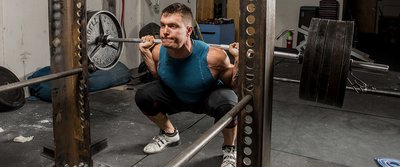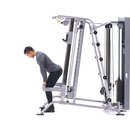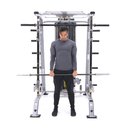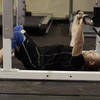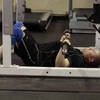Just about every city has a hardcore gym where only the most serious lifters come to train. Their tools include chalk, knee wraps, and lots of heavy plates. But where do the truly elite go—the hardest of the hardcore? What gym do the world's biggest and strongest call home?

That would be Louie Simmons' place, the invitation-only Westside Barbell in Columbus, Ohio. By all accounts, it's the world's most hardcore powerlifting gym. Simmons, himself a renowned powerlifter and strength coach, has not only amassed some of the strongest men and women in strength sports—currently its members hold 5 of the top 10 powerlifting totals of all time—but his techniques and methods continue to draw only the most advanced disciples of iron.
Among the techniques he's developed to strengthen the already supersized is the Conjugate Method training system (sometimes called the Westside Method), which employs single repetitions as one of its core training tenets.
"Your body responds to the demands placed upon it, so when you handle heavy weights, that's how you get stronger and stronger all the time," Simmons says. "Remember, when you go to a contest, they don't ask you to do three reps, they ask you to do one."
Many respectable exercise physiologists may shudder at the thought of a protocol that involves a short, focused warm-up—repping only with the 45-pound barbell—followed by a series of one-rep sets that quickly ratchet up the weight to an ever-advancing personal best. They would much prefer the so-called "safer" route of ample warm-ups and sets of at least 5-6 reps to the brutish, unyielding pursuit of single tests of strength every week.
To that, we suggest closing your outmoded textbook for a moment and considering the facts: the wildly successful results of Simmons' approach. You might be surprised to learn that the Westside Method not only builds a freakish amount of strength, but can also be used for packing some serious lean mass.
The Westside Story
Since being founded in the early '80s in Louie's garage, Westside Barbell has boasted numerous champions in the realm of powerlifting and other sports, including the NFL and UFC. Among its record holders are 36 men who've benched more than 700 pounds—two of whom cracked 900—and 19 athletes who have squatted more than 1,000 pounds—two of whom reached the rarified air of 1,200. All of the incredible marks are scrawled on a chalkboard that hangs on an otherwise utilitarian white-slab wall in the facility, facing an array of benches, racks, and thousands of pounds of well-worn iron.
Simmons himself has competed for more than 50 years, and has racked up a 920-pound squat, a 600-pound bench, and a 722-pound deadlift. In fact, he's one of only five lifters to total Elite—the top 1 % of all competing powerlifters—in five different powerlifting weight classes.
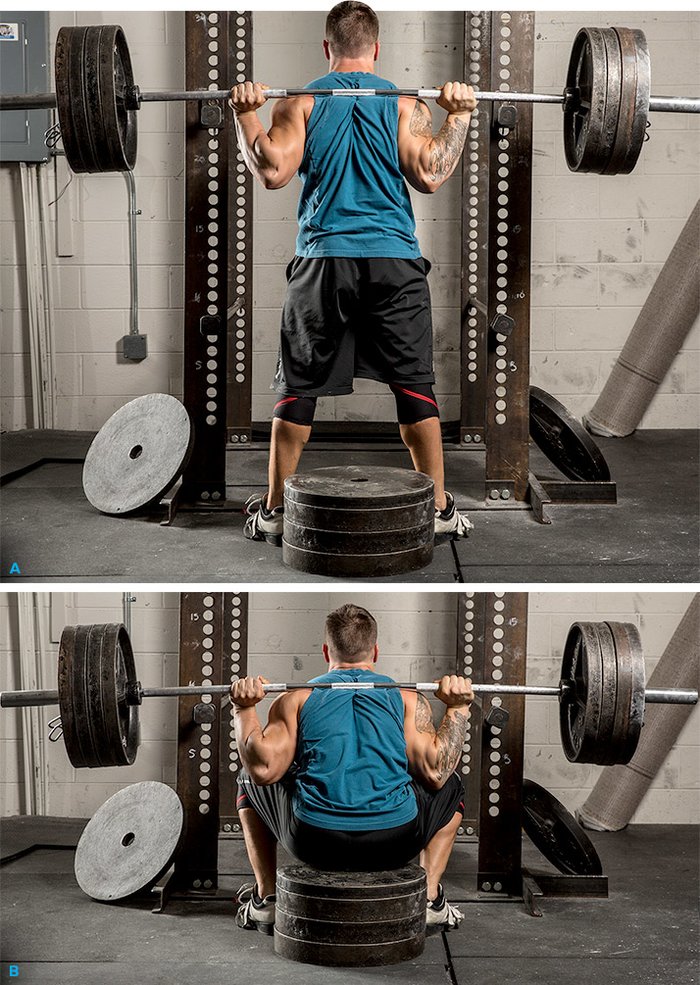
Box Squat
The 67-year-old Simmons has been a lifelong student of human development. "I used the data and journals from hundreds of the greatest Russian and Bulgarian weightlifters in [creating the tenets of] the Conjugate Method," he says.
"I looked at what they were doing; they were way ahead of us in terms of strength training. It's why the system includes two types of workouts per week, a low-volume day (called "max effort") where the intensity is 100 percent as we get to the biggest weight possible, and a higher-volume day (called "dynamic effort") where we lift faster at 75-85 percent of the one-rep max."
Westside for Muscle Growth
Simmons—a tattooed, resolute, bear of a man—is also perfectly aware of the major concern with his program: the alleged potential for injury. However, he is convinced by five decades of in-the-trenches experience that not only is his method safe, but it could virtually eliminate bodily breakdowns altogether if followed precisely.
"Really, only 20 percent of your training here is max or near-max barbell work," he says. "The rest, I don't want to call it bodybuilding, but 80 percent is basically hypertrophy training. You're always focusing on improving your weaknesses. That way, you won't have muscle imbalances and you'll constantly get stronger and eliminate injuries. There's too many injuries in this sport, and there basically shouldn't be any."
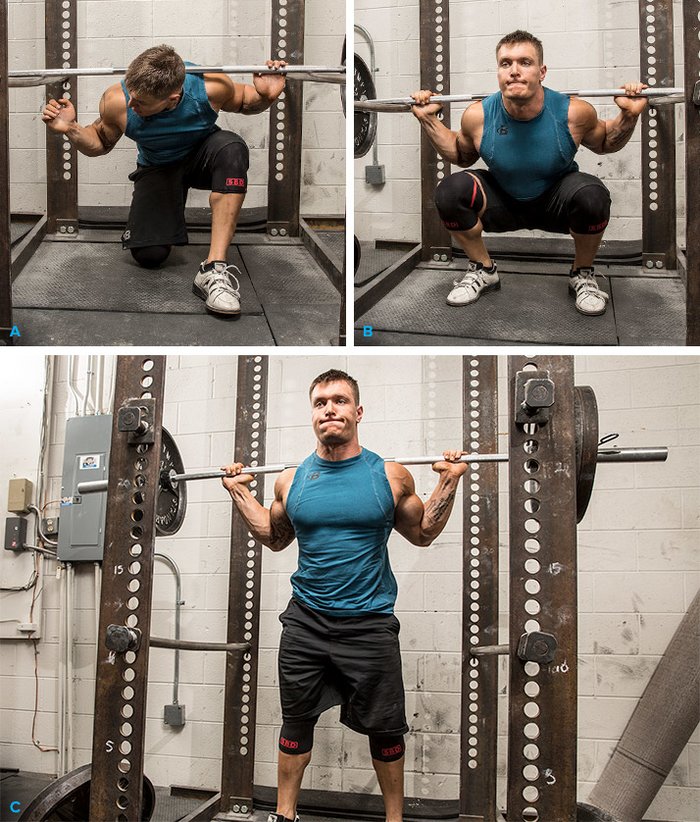
Concentric Power Rack Squat
Simmons is convinced the same methodology he uses on men and women who live and breathe powerlifting meets and record-shattering feats of strength in front of admittedly sparse but fervent crowds can also work for the regular guy, the one who wants an athletic build and appreciably more muscle mass. Training with the Conjugate Method is a fast track to those goals. That's because pure strength equals muscle gains, a simple equation as old as lifting itself.
The Three Lifts You'll Rarely Do
Before getting into the nuts and bolts of the program, it'll help to know two key facts—both of which are often surprising to those first venturing into the ways of Westside. First, contrary to what you might think, you'll rarely do the three central powerlifting exercises—the bench press, deadlift, and squat. And second, as alluded to earlier, you'll set new personal bests every time you step foot in the gym.
"I would test a real squat, bench, and deadlift no more than once every 6-10 weeks," Simmons explains. "You don't get stronger by setting records in those lifts; you get stronger by training."

"You don't get stronger by setting records in the bench press, deadlift, and squat; you get stronger by training."
Specifically, you use movements similar to the big three—exercises that produce adaptations in your strength levels and lifting technique that lead to more power in the bench, squat, and dead. So for the bench, you do incline and decline presses, power-rack presses, floor presses, and board presses, along with ancillary work that focuses on the upper back and triceps. According to Simmons, those two muscle groups are "the true foundations of a better bench press."
For the deadlift and squat, you perform box squats, rack pulls, and good mornings, among an array of movements, many of which emphasize the oft-overlooked glutes and hamstrings.
Breaking Records, Building Mass
As for breaking a record in every workout, Louie and the members of Westside practice what he preaches. "Ninety-five percent of our workouts at Westside involve a personal record in a lift, where you exceed your best by maybe five pounds," he says. "That may not sound like much to some, but that's 60 pounds a year for exercises you're doing once a month."
Besides the obvious physical gains, there's a cerebral component, as well. "If every day you're coming in and breaking a record, your mind is immediately set to break records. It gets used to success instead of failure. When you're not making progress like that, it's why people plateau and quit. That's why they suffer from mental fatigue. You eliminate that with the Conjugate system."
Your Westside Plan
With that in mind, here's the potent Westside program, boiled down to its simplest elements—that is, sans the bands and chains, chalk and knee wraps—Simmons has been adding to traditional lifts since 1990 to increase tension at the upper end of the range of motion. In other words, here's Westside for anyone with access to a moderately equipped gym and a burning desire for hard work.
The Westside Split
- Monday (A) - Max-effort lower body (deadlift/squat)
- Wednesday (B) - Max-effort upper body (bench)
- Friday (C) - Dynamic-effort lower body
- Sunday (D) - Dynamic-effort upper body
Plus one day of training weak points: an hour of various exercises, 3-4 sets of 6-10 reps.
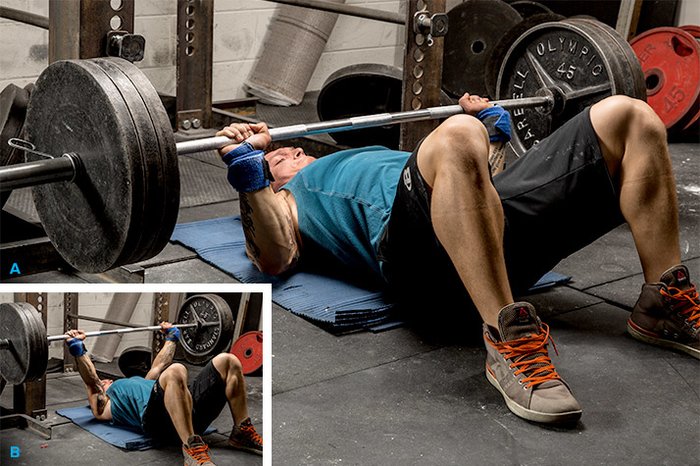
Floor Press
Max-Effort-Day Instructions (Days A and B)
Max days (Mondays and Wednesdays) all involve a personal record—that is, you'll be doing one main exercise in which you'll break your previous best by five pounds. Start with a thorough warm-up using the bar, then go right into singles, pyramiding up as fast as you can safely to reach your record-breaking lift, resting no more than 2-3 minutes between sets.
For example, when doing incline bench, if your previous best was 490 you might go 225, 275, 315, 365, 405, 455, and 495.
You'll rotate between 4-6 different max exercises, one per week, so you never do the same exercise for a max within the course of a month.
After your max lift, you'll finish with 4-6 ancillary exercises of 6-10 reps per set, including various dumbbell presses and intensive triceps work on bench day. "The triceps are a prime mover on a bench press, along with the pecs," Simmons explains.
You'll also do a lot of rows and hamstring work on deadlift/squat day.
A. Lower-Body Max-Effort Exercise Options
- Low-box front or back squat
- Barbell rack pull
- Concentric power-rack squat
Note: Each of these movements can be further modified into a "new" exercise by altering stances (from narrow to standard to sumo-style) and range of motion (for example, rack-pulling from various heights).
Lower-Body Ancillary Exercise Options
- Barbell good morning (once a month, for 3-5 reps per set)
- Heavy sled pull
- Dumbbell row
- Bent-over barbell row
- Upright barbell row
- Power clean
- Power snatch
- Standing leg-curl machine
- Reverse hyperextension on glute-ham bench
- Romanian deadlift
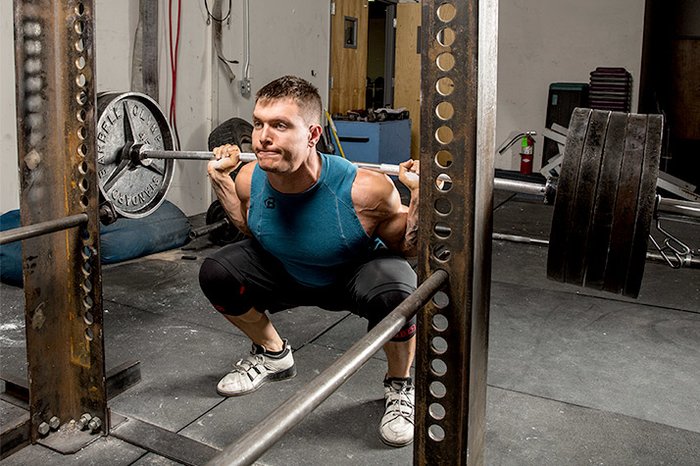
Barbell Squat
Here’s how a conjugate-style max-effort lower-body day might look in action:

BodyFit
$6.99/month- 2,500+ expert-created single workouts
- 3,500+ how-to exercise videos
- Detailed workout instruction
- Step-by-step workout tips
- Training at gym or at home
- Access to Workout Plans
- Access to Bodyfit App
- Store Discounts
Already have a Bodybuilding.com account with BodyFit? Sign In

What comes with BodyFit?

- Instructional Videos
Don't risk doing a workout improperly! Avoid injury and keep your form in check with in-depth instructional videos.

- How-to Images
View our enormous library of workout photos and see exactly how each exercise should be done before you give it a shot.

- Step-by-Step Instructions
Quickly read through our step-by-step directions to ensure you're doing each workout correctly the first time, every time.
B. Upper-Body Max-Effort Exercise Options
- Incline barbell press
- Decline barbell press
- Power-rack bench press
- Floor press
- Board press
Note: Each of these can be further modified into a "new" exercise by altering grip width (from narrow to standard to ultra-wide) and range of motion (for example, setting the pins higher or lower in the power-rack bench).
Upper-Body Ancillary Exercise Options
- Incline or decline dumbbell press
- Lying triceps extension (aka skullcrusher) with a barbell, EZ-bar, or dumbbells
- Close-grip barbell press
- Pull-over with a barbell, dumbbell, or kettlebell
- Parallel-bar dip
- Push-up (various grip widths)
Here’s how a conjugate-style max-effort upper-body day could look:

BodyFit
$6.99/month- 2,500+ expert-created single workouts
- 3,500+ how-to exercise videos
- Detailed workout instruction
- Step-by-step workout tips
- Training at gym or at home
- Access to Workout Plans
- Access to Bodyfit App
- Store Discounts
Already have a Bodybuilding.com account with BodyFit? Sign In

What comes with BodyFit?

- Instructional Videos
Don't risk doing a workout improperly! Avoid injury and keep your form in check with in-depth instructional videos.

- How-to Images
View our enormous library of workout photos and see exactly how each exercise should be done before you give it a shot.

- Step-by-Step Instructions
Quickly read through our step-by-step directions to ensure you're doing each workout correctly the first time, every time.
Dynamic-Effort-Day Instructions (Days C and D)
On these days, you'll do 1-2 main exercises, this time for 10-12 sets of 2 reps using 75-85 percent of your one-rep max (which is typically a weight you can handle for about 6-10 reps), resting no more than a minute between sets.
On the lower-body day, do a variation of the box squat, changing the height of the box or your stance, and stick with it for three weeks before changing it up and recalibrating your one-rep max starting point. Do a variation of the rack pull as well. On the upper-body day, you'll do a variation of the bench press as your main exercise.
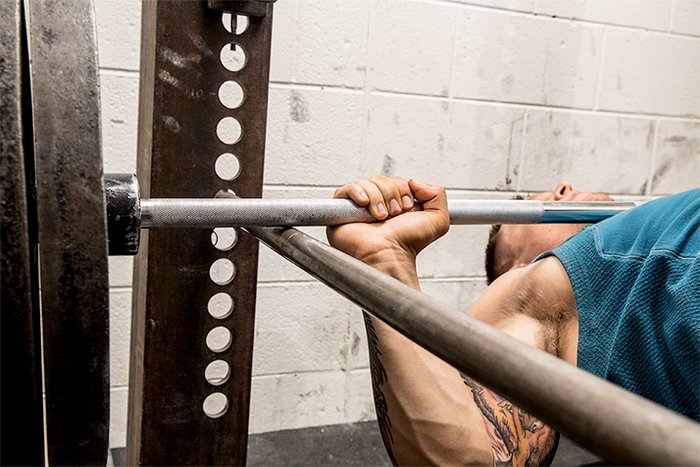
Low Pin Bench Press
"Do the lift as fast as possible," Simmons says. "You want to push it as hard as you can through the full range of motion. On dynamic-effort days, we use chains or bands to increase tension and resistance as you reach the end of a range of motion, but if you don't have those tools, just focus on maximizing speed under control."
After your main lifts, you'll finish with 4-6 ancillary exercises of 6-10 reps per set, focusing on the quads, hamstrings, and glutes (as well as heavy rows) on the deadlift/squat day and shoulders, back, traps, and triceps on the upper-body day. You can choose movements from the ancillary lists above.
Exercise Notes
Simmons is a world-class coach, so you can bet he has some thoughts on exercise performance. If you choose to follow the Westside split and employ the prescribed exercises and ancillary movements, you'd be wise to heed the following advice.
Low-box squat
"Do these in a power rack, sitting down on a low box, about 10 inches high," says Louie Simmons. "You'll sit down all the way, then stand up. It really helps build up your deadlift. If you have weak hips, use a wide stance, and if you need more lower-back work use a close stance."
Barbell rack pull
"We'll do rack pulls with the plates on mats 2-, 4-, or 6-inches high, or with the barbell on the floor and the lifter on a mat," Simmons says. "We never do a regular deadlift in training—you're either standing on a mat or the plates are on a mat. We do rack pulls on the lower-body max day two of the four weeks in a month."
Concentric power-rack squat
"With these, you're doing only the concentric part of the rep," Simmons says. "In a power rack, you crawl underneath the bar that's set at the bottom position, get under it, and drive the weight up."
Barbell good morning
Westside lifters rotate between two variants of the good morning, performing them with an arched or rounded back. The former involves holding the bar throughout the movement as if you were doing a wide-stance squat—chest out and shoulders back, core flexed to hold the natural arch of your lower back. For the latter, you stand with feet together and round your back as you bend forward at the hips. In this version, keeping the knees straight targets the erector spinae, while a bent knee activates the hamstrings to a greater degree.
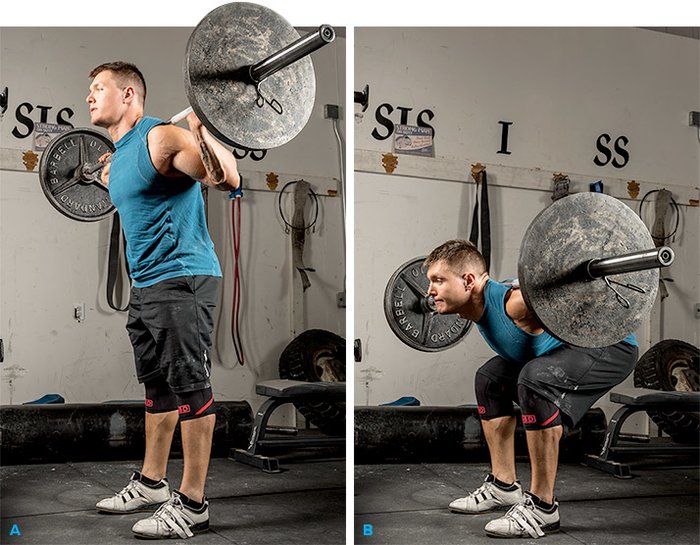
Good Morning
Power-rack bench press
The power-rack bench press makes expert use of the safety rods. You stick a bench inside the rack, then position the safety bars to either "high" or "low." High limits you to the upper half of your typical range of motion, while setting the safeties low helps you drive the bar up from that point.
Floor press
The floor press helps build more driving power at the midpoint of the bench press range of motion. By removing your legs from the equation—yes, your legs are involved in bench pressing—the floor press means all the effort comes from your chest, shoulders, and triceps.
Skullcrusher
Think skullcrushers are just for aesthetics? Think again. "On film I saw powerlifting great Ted Arcidi bench 600 for 9 reps," Simmons recalls. "In training he did a lot of skullcrushers to his nose; I watched him do 350 for sets of 6, so that was a heavy triceps workout. But that's where he got a lot of his bench-pressing strength."
A Final Word On Core Training
Before you run wild into the heavy world of Westside training, don't ignore your core. Simmons recommends doing abs before and after every workout. His favorites include hanging leg raises, leg raises off the floor, static ab holds in a lat pull-down or pull-over machine, heavy dumbbell side bends, straight-leg sit-ups, and decline-bench sit-ups.


